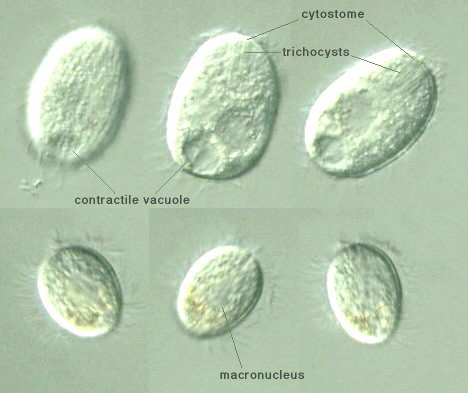

Prostomatea:
Prorodontida: Prorodontidae
Prorodon diaphanus
Dragesco, 1960
 Genus:
Ovoid to cylindrical; ciliation uniform; oral basket made up of double trichites which end up
deep in ectoplasm; contractile vacuole terminal (Kudo, 1966).
Brosse as 3 longitudinal files (Illustrated Guide, 1985).
Body ellipsoidal, ovoid or cylindrical in shape; cytostome apical, circular;
cytopharynx equipped with well-developed double nematodesmata; somatic ciliation uniform,
kinetosomes paired; macronucleus ovoid, reniform or ellongate; as many species descriptions
are insufficient, many are indistinguishable (Carey, 1992).
Genus:
Ovoid to cylindrical; ciliation uniform; oral basket made up of double trichites which end up
deep in ectoplasm; contractile vacuole terminal (Kudo, 1966).
Brosse as 3 longitudinal files (Illustrated Guide, 1985).
Body ellipsoidal, ovoid or cylindrical in shape; cytostome apical, circular;
cytopharynx equipped with well-developed double nematodesmata; somatic ciliation uniform,
kinetosomes paired; macronucleus ovoid, reniform or ellongate; as many species descriptions
are insufficient, many are indistinguishable (Carey, 1992).
Species:
A small transparent species, 50 μm long;
cell body ovoid; kineties 22 or 24; mucocysts can be observed in the cortex;
cytostome apical and quite large, equipped with trichocysts;
cilia around the cytostome longer; macronucleus large; contractile vacuole terminal (Carey, 1992).
|
Prorodon sp. (diaphanus ?),
cell body ovoid, cytostome large, equipped with trichocysts,
41 μm long, 27 μm wide, macronucleus large, about 24 kineties,
x 400, x 640, Japan, 1999 by Y. Tsukii
 50 μm
50 μm
 100 μm
100 μm
 150 μm; x 400 :
150 μm; x 400 :
 31 μm
31 μm
 63 μm
63 μm
 94 μm; x 640
94 μm; x 640




Prorodon (diaphanus ?),
cell body 30 μm long, 20 μm wide, a starved cell ?,
x 400, x 640, 1999 by Y. Tsukii
 50 μm
50 μm
 100 μm
100 μm
 150 μm; x 400 :
150 μm; x 400 :
 31 μm
31 μm
 63 μm
63 μm
 94 μm; x 640
94 μm; x 640




Prorodon teres Ehrenberg, 1838:
Body cylindrical, caudal cilia absent; a single macronucleus;
130-200 μm long; large cytopharyngeal
apparatus (Carey, 1992). Similar to P. marinus, P. mimeticus, P. moebiusi, P. morgani, P. nucleatus,
P. opalescens, P. penardi
Prorodon discolor (Ehrenberg, 1831) Kahl, 1930
(Syn. Holophrya discolor Ehrenberg, 1831; Prorodon discolor var. marinus Kahl, 1831):
Body ovoid, rather pointed posteriorly,
90-110 μm long;
apical cytostome and well-developed basket; trichocysts and mucocysts present; contractile vacuole
terminal; macronucleus oval with a central core (Carey, 1992).
Prorodon diaphanus Dragesco, 1960:
A small transparent species, 50 μm long;
cell body ovoid; kineties 22 or 24; mucocysts can be observed in the cortex;
cytostome apical and quite large, equipped with trichocysts;
cilia around the cytostome longer; macronucleus large; contractile vacuole terminal (Carey, 1992).
Prorodon marinus Claparède & Lachmann 1858:
100 μm long; many vacuoles (Carey, 1992).
Prorodon nucleatus (Svec, 1897) Penard, 1922:
120-160 μm long;
ellipsoidal cytostome; highly contractile (Carey, 1992).
Prorodon mimeticus Kahl, 1930:
130-200 μm long;
dorsal brush visible; clear cytoplasm (Carey, 1992).
Prorodon opalescens Kahl, 1928:
180-200 μm long;
clear cortex with trichocysts (Carey, 1992).
Prorodon penardi Dragesco, 1954:
180 μm long; large macronucleus
(Carey, 1992).
Prorodon moebiusi Kahl, 1930:
200-300 μm long; pointed posterior
(Carey, 1992).
Prorodon morgani Kahl, 1930:
250-400 μm long;
cell body cylindrical and plump (Carey, 1992).
# All these species cylindrical in shape, a single macronucleus, no caudal cilia (Carey, 1992).
Please click on images for viewing enlarged.
Copyright
Protist Information Server
 Genus:
Ovoid to cylindrical; ciliation uniform; oral basket made up of double trichites which end up
deep in ectoplasm; contractile vacuole terminal (Kudo, 1966).
Brosse as 3 longitudinal files (Illustrated Guide, 1985).
Body ellipsoidal, ovoid or cylindrical in shape; cytostome apical, circular;
cytopharynx equipped with well-developed double nematodesmata; somatic ciliation uniform,
kinetosomes paired; macronucleus ovoid, reniform or ellongate; as many species descriptions
are insufficient, many are indistinguishable (Carey, 1992).
Genus:
Ovoid to cylindrical; ciliation uniform; oral basket made up of double trichites which end up
deep in ectoplasm; contractile vacuole terminal (Kudo, 1966).
Brosse as 3 longitudinal files (Illustrated Guide, 1985).
Body ellipsoidal, ovoid or cylindrical in shape; cytostome apical, circular;
cytopharynx equipped with well-developed double nematodesmata; somatic ciliation uniform,
kinetosomes paired; macronucleus ovoid, reniform or ellongate; as many species descriptions
are insufficient, many are indistinguishable (Carey, 1992).







